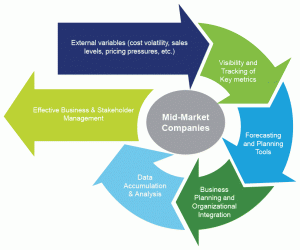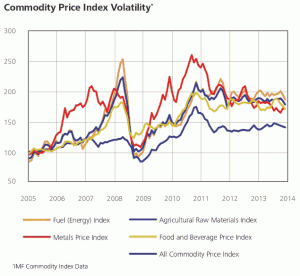SVP,
Deloitte Transactions and Business Analytics
SVP,
Deloitte Transactions and Business Analytics
As turnaround professionals, we have seen first-hand how the imbalance between risk investment and an aggressive growth appetite can drive companies into distressed situations. As the economy continues its modest growth, mid-market companies are eager to throw off the cautiousness and fortress mentality of the recent past. However, upper management charged with managing expansion must do so amid prospects of a constantly changing external environment. Unfortunately, most will have limited forecasting and risk management tools.
Risk mitigation, be it financial or operational, is especially important for mid-market companies where volatility in pressure points can have an immediate, detrimental impact. These companies, once caught in a distressed situation, can find it is too late to react to a reality that does not support the growth ambitions of leaders. In order to succeed, mid-market company leaders need to integrate operational and financial planning using appropriate tools, as well as establish strong data governance without significant investment in new technology, but rather through an emphasis on better use of existing enterprise resource planning and other systems.
Lack of Planning, Integration

A host of factors can add to the pressures confronting mid-market companies, such as declining sales due to external conditions or structural shifts in the industry, loss of key customers, pricing pressures or shocks in the input costs. An example of these factors is volatility in the commodity prices, which have been all over the map since the Great Recession. For companies that use basic commodities in their products, volatile prices can be a game-changer — and not always a positive one. This is especially true for the smaller mid-market company that may not have a sophisticated hedging program in place or may already be experiencing some form of underperformance or distress.

Mid-market companies generally do not have the budget to implement the sophisticated performance tracking or risk management tools accessible to their larger, more stable corporate brethren. But a complete lack of key tools and processes to assist in timely identification of issues and contingency planning can bring significant trouble for these companies. So how can you help steer your client away from the shoals of distress? The following are lessons from our experience.
Need for Metrics
Our experience in the middle market has shown us that deployment of financial and operating metrics may be lacking. In the case of one client, information was abundant, but never assembled in a way to provide a timely picture of company’s performance. As a result, sales dips and spikes in key production costs were not identified until weeks, and in some cases, months after the fact. By that time, it was too late to react to avoid liquidity shortfalls and bank covenant issues.
Even having a one-page “pulse report,” which shows key metrics for tracking revenue, operating performance and working capital is highly effective. These metrics need to be studied objectively by the entire organization, and applied consistently. Key metrics should be tracked on a weekly, or even a daily, basis as less mature and less capitalized mid-market companies may need to adjust their plans rapidly.
Forecasting
Real-time tracking of performance indicators is one thing. Being able to use that information to analyze financial sensitivities and develop action plans to react is another. We have worked with many clients that lack the basic financial modeling tools to provide this timely and accurate insight into the impact of external changes on earnings and cash-flow.
In one situation, our client experienced significant growth in recent years, quickly establishing itself as a leader in its market. However, the company’s forecasting and planning tools did not keep up with the growth. Its scenario forecasting model was so basic, it did not consider fixed versus variable costs, nor did it incorporate changes in internal and external variables in a timely manner. As a result, unexpected changes set in motion a host of issues, from liquidity shortfalls to credibility problems with stakeholders. It seems a simple-enough story, but it’s one we see often in our client base.
A basic, but nimble, financial modeling tool with a simplified form of scenario or sensitivity planning can go a long way in providing the information necessary to evaluate the extent of a financial hole, understand the impact of action plans and communicate with key stakeholders.
Enterprise Strategy
Tracking changes in the external environment and understanding financial impacts are only part of the puzzle. Being able to react operationally is the other critical piece. Our previously mentioned client had virtually no cross-functional planning between sales, operations and finance. This resulted in lack of a cohesive organizational strategy. Financial projections were prepared on sales forecasts not commonly known throughout the company, and product mix and margin goals were not consistently understood.
The disconnect in the organization resulted in the sales force selling on a “gut” feeling instead of sticking to the product mix and margin goals in the financial plan. Production strategies were based on filling capacity rather than demand-side forecasts. Despite meeting sales projections, the company’s margins were often significantly less than projected, and leadership did not have processes in place to align segments of the organization together to react effectively.
In order for a company to develop a cohesive business plan and be ready to react when actual results fall short of the plan, it must have a business planning function that integrates various entities within the organization. Someone from the C-suite should drive this process integration to bridge the gap between the finance department, sales and supply chain.
Informational Tower of Babel
Many mid-market companies are behind in collecting and analyzing data efficiently and effectively. They either don’t collect it, or collect it in a cumbersome way that makes it hard to pull together in a clear manner.
We have seen many instances where several functions in one company use different or inappropriate information, look at one small piece of a larger data set or interpret the same information differently. If no one coordinates the gathering and ranking, competing areas in the organization will use it piecemeal, creating disparate analyses that produce varying conclusions. This results in an informational Tower of Babel that yields to a lack of insight into the real financial or operational picture.
C-Suite executives need to serve as the information cop by deciding what data to use, and interpreting it, to facilitate company-wide decision making.
Implications: Missed Loan Covenants
While no one can predict the risks an organization will face, it doesn’t take much to push a mid-market company into a distressed situation. As we have seen, clients can miss loan covenants, throwing them into technical default and potential cash shortfalls. The organizational focus then shifts to damage control and crisis management, causing stress in the C-suite and for customers, vendors, lenders and investors. Above all, these activities distract management from operating the business.
With the right mix of analytical tools and company integration/adoption, you can support your mid-market leaders in recognizing issues quickly to help them react cohesively and effectively.
Vipul Adlakha and Kyle Richter are senior vice presidents in Deloitte Transactions and Business Analytics LLP, where they provide financial and operational restructuring services to underperforming companies, their lenders, investors and other stakeholders.


